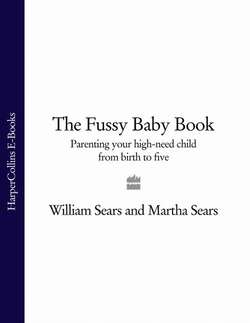Читать книгу The Fussy Baby Book: Parenting your high-need child from birth to five - Martha Sears - Страница 48
not a self-soother
ОглавлениеAnother unrealistic expectation many new parents have is that babies will soothe themselves to sleep with the help of a dummy, a musical box, or some baby-calming gadget. High-need babies won’t accept that. They need to interact with people, not things. Parents will often report, “He just can’t relax by himself.” Most babies need help to fall asleep. A parent who rocks, jiggles, walks, or dances with a baby at bedtime acts like a shock absorber for the day’s stimulation and frustration. High-need babies must learn to trust their parents to help them. This will help them learn to relax on their own, a skill that has value for a lifetime. Crying oneself off to sleep is not a good way to learn to relax. The best way for a baby to learn to relax and fall asleep is to have his behaviour shaped for him by a parent. Once a child learns to relax on his own, he’ll have no trouble falling asleep on his own.
The quality of wanting people instead of things as comforters, while initially exhausting, will eventually work to the child’s advantage. The child will have a better grasp on interpersonal relationships, especially being comfortable with the quality of intimacy. (See the related section on intimacy on page 219.)
We learned early on that Amy was a people person. She preferred anything human to anything synthetic or mechanical. We tried a host of different things designed to soothe or entertain small infants, but Amy would have none of them. At our childbirth class reunion, all the other babies seemed quiet and content, sitting in infant seats or lying peacefully on the floor. Amy wanted and needed to be in our arms. That day, we got a lot of suggestions about ways to help her. Many other parents were extolling the virtues of the mechanical swing, telling of the many hours their baby would spend in it. Babies who had not tried one were put in the host’s swing and almost always promptly fell asleep. We dutifully tried Amy in it and she cried immediately. Over the months that followed, we learned in no uncertain terms that she preferred arms to the cradle and the breast to the bottle. We came to respect this tendency in her. The pushchair, the cradle, the infant seats were all put away until she signalled that she was ready to be more physically separate from us. Now, at nearly a year old, she sleeps peacefully on a futon at naptime and loves taking rides in the pushchair and backpack. That time of needing intense physical contact was quite short. We’re proud that we were able to be there for her in the way that she needed us to be.
